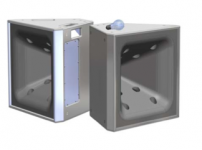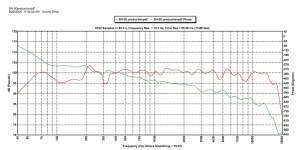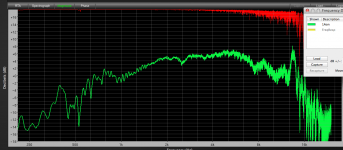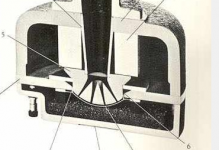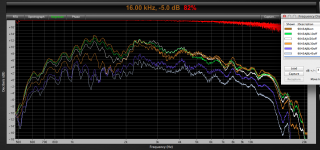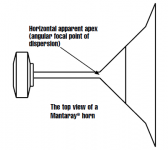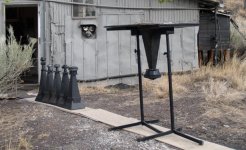Steve,I'm not real fond of EQing the 288 flat in the manta-ray horns. I think if I were to go that route, I use that BMS? concentric HF driver.
The reason I want six of these speakers is for surround sound, so it's not like they will all be playing at once.
Sounds like you have a fun job!!
It is fun, but the gigs are fairly few and far between.
The diffraction slot on a Manta Ray horn makes HF sound hashy when boosted to provide flat response.
A conical horn does not have that problem, and still maintains constant directivity of the initial sidewall angle.
I have compared the same drivers on a "pinched throat" diffraction style horn (I had kind of copied the Manta Ray design, shrunk for a 1500 Hz Xover) and a conical using the Hughes Quadratic throat type transition, and the difference was quite apparent even to my old abused ears.
You could make a quick prototype to verify what I say, just make a round to square (or rectangular, depending on what pattern you want) adapter from wood, and duct tape it to cardboard horn sidewalls.
Since you are going to use 6 horns, you probably don't need over 50 degrees dispersion.
Copying the approximate dimensions of the DSL SH50 would be a good idea, cut four triangles 28" wide, about 24" deep, around 2" at the pointy end where they go to the round to square adapter.
Obviously the cardboard won't hold up at high power levels, but will give you an idea of how good conical horns sound.
Doing the Keele angle break for the last 1/3 of the horn (a good part of the Manta Ray design) improves the sound quality, that feature has been employed in the DSL conical horns.
Art
Attachments
Weltersys,
I couldn't disagree with you more. Any conic horn I have ever listened to would require massive amounts of eq to sound anything like flat. Most any compression driver is designed to work with an exponential expansion rate. I don't know of any compression drivers that are older that were ever intended for a conic horn flare.
I couldn't disagree with you more. Any conic horn I have ever listened to would require massive amounts of eq to sound anything like flat. Most any compression driver is designed to work with an exponential expansion rate. I don't know of any compression drivers that are older that were ever intended for a conic horn flare.
Kindhornman,Weltersys,
I couldn't disagree with you more. Any conic horn I have ever listened to would require massive amounts of eq to sound anything like flat. Most any compression driver is designed to work with an exponential expansion rate. I don't know of any compression drivers that are older that were ever intended for a conic horn flare.
You are free to your opinions, but the fact is conical horns can be EQd flat even with passive components, as can be clearly seen in the frequency and phase response of the three way Danley SH 50 using a passive crossover below.
The other chart is of an EV DH1A-16 on a Maltese conical horn, no EQ.
The DH1A and the Altec 288 are similar, though the titanium diaphragm has an upper peak the 288 will probably lack.
The Altec 288 was designed in the days when most horns were exponential, but that does not mean it won't work fine on a conical, as long as the exit angle is faired to the horn wall smoothly.
Art
Attachments
No that room is not mine, I understand it is in France, and JMMC had a hand in the horn design, iirc... but I sure like the way it looks! 
Having owned examples of the big Mantaray, my issue with them is/was that there is a clear discontinuity in terms of the apparent acoustic "source" between the highs and lower freqs that seems to track in sections, from the diffraction exit, to the "breaks" in the horn wall. I found it disconcerting. Probably a non issue at some many yards away, but not in a home environment.
Perhaps this doesn't happen the same way without the diffraction slot. I don't know.
There is an issue with going from the usual exponential slow flare of the older drivers to a rapid expansion according to Geddes (iirc - don't want to misquote). The new JBL with neodymium mags have a very short exit area and might do a better job in that respect...
However I'd be surprised if the polar response at higher freqs, especially with a traditional driver exit spliced on to a fast expansion (Geddes/Hughes) or a conic horn would not look like a short narrow exponential (closer to conic anyhow) section, and ignore the expansion pretty much. In other words narrowing polar response with raising frequency, probably with a pretty clear point where it switches from one flare rate to the other... at lower freqs likely it works fine.
just blabbering random thoughts...
_-_-
Having owned examples of the big Mantaray, my issue with them is/was that there is a clear discontinuity in terms of the apparent acoustic "source" between the highs and lower freqs that seems to track in sections, from the diffraction exit, to the "breaks" in the horn wall. I found it disconcerting. Probably a non issue at some many yards away, but not in a home environment.
Perhaps this doesn't happen the same way without the diffraction slot. I don't know.
There is an issue with going from the usual exponential slow flare of the older drivers to a rapid expansion according to Geddes (iirc - don't want to misquote). The new JBL with neodymium mags have a very short exit area and might do a better job in that respect...
However I'd be surprised if the polar response at higher freqs, especially with a traditional driver exit spliced on to a fast expansion (Geddes/Hughes) or a conic horn would not look like a short narrow exponential (closer to conic anyhow) section, and ignore the expansion pretty much. In other words narrowing polar response with raising frequency, probably with a pretty clear point where it switches from one flare rate to the other... at lower freqs likely it works fine.
just blabbering random thoughts...
_-_-
Bear,There is an issue with going from the usual exponential slow flare of the older drivers to a rapid expansion according to Geddes (iirc - don't want to misquote). The new JBL with neodymium mags have a very short exit area and might do a better job in that respect...
However I'd be surprised if the polar response at higher freqs, especially with a traditional driver exit spliced on to a fast expansion (Geddes/Hughes) or a conic horn would not look like a short narrow exponential (closer to conic anyhow) section, and ignore the expansion pretty much. In other words narrowing polar response with raising frequency, probably with a pretty clear point where it switches from one flare rate to the other... at lower freqs likely it works fine.
You will be surprised by the chart below then.
The chart shows the horizontal response of a small (about 13.5" wide) 90 x 45 conical expansion horn with a Hughes type throat using a JBL 2420 with an aftermarket titanium diaphragm.
The measurements were made outside, on axis and at 10 degree intervals out to 40 degrees, then one at 45 off axis
The "traditional" 2420 throat is over 2" deep and about 11 degree exit angle, but as you can see, dispersion on the 9045A horn is quite uniform, only 2 dB less at 45 degree off axis at 16kHz than the rest of the uniform 6 dB down.
The horn shows a little "waistbanding" (as Earl calls it) around 2000 Hz, and goes omni below 500 Hz due to the small mouth size, but the HF dispersion is quite uniform.
And the horn just plain sounds good, completely lacking the issues we have both heard in the "pinched throat" CD horns.
An Altec 288 has a larger exit than the 2420, which will affect HF dispersion, but if Steve were to shoot for around 50 degree rather than 90 degree, I doubt it would be an issue at all.
Certainly would be less of an issue than the "fingering" HF lobes of a multicell ;^).
Art
Attachments
I agree with both those thoughts.discontinuity in terms of the apparent acoustic "source" between the highs and lower freqs. <snip>Probably a non issue at some many yards away, but not in a home environment.
I'll scratch your back if...just blabbering random thoughts...
You are very welcome, always glad to help. Nice that GM found the Altec plot, to me it's more useful than a polar. Hope it helped you, too.Sorry Pano, I forgot to THANK YOU for that very kind offer!
The diffraction slot on a Manta Ray horn makes HF sound hashy when boosted to provide flat response.
Yes, hashy is a great way to describe the boosted HF response of the MR/288 combo. But I like the MR-64's from 400- 7Khz with minimal eq.
I was planning on using the MR horns for surround duties and the 1003's for mains. At some point I may replace the MR horns with 1003's - might be worth a road trip to Oklahoma since shipping these horns is so expensive.
A conical horn does not have that problem, and still maintains constant directivity of the initial sidewall angle.
I have compared the same drivers on a "pinched throat" diffraction style horn (I had kind of copied the Manta Ray design, shrunk for a 1500 Hz Xover) and a conical using the Hughes Quadratic throat type transition, and the difference was quite apparent even to my old abused ears.
It's good to know that it's the horn and not the driver.
You could make a quick prototype to verify what I say, just make a round to square (or rectangular, depending on what pattern you want) adapter from wood, and duct tape it to cardboard horn sidewalls.
Since you are going to use 6 horns, you probably don't need over 50 degrees dispersion.
Copying the approximate dimensions of the DSL SH50 would be a good idea, cut four triangles 28" wide, about 24" deep, around 2" at the pointy end where they go to the round to square adapter.
Obviously the cardboard won't hold up at high power levels, but will give you an idea of how good conical horns sound.
Doing the Keele angle break for the last 1/3 of the horn (a good part of the Manta Ray design) improves the sound quality, that feature has been employed in the DSL conical horns.
I will try out the idea at some stage, but this theater is a huge project and the speakers are just part of it. Those conical 80hz horns were a little rushed when I 'designed' them. So it's a case of unfinished business - I want to see how much I can improve the design. But the great thing about active crossovers and horns - it's so easy to mix things up down the track.
Do you have more info on the Keele break? That was something I wanted to employ in my last 80hz horn, but lacked the time/knowledge. I know a simple straight conical horn is not the best design, but I'm not sure what flare's are needed where. First 1/3 is for determining the dispersion? Second third for loading the driver? and the last 1/3 for avoiding reflections back into the horn mouth and for smoothing the FR response?
Ahhh.... horns. The more I know, the more I realize how little I really know.
Just like women, it must be those nice curves that keep me entranced.
No that room is not mine, I understand it is in France, and JMMC had a hand in the horn design, iirc... but I sure like the way it looks!
Having owned examples of the big Mantaray, my issue with them is/was that there is a clear discontinuity in terms of the apparent acoustic "source" between the highs and lower freqs that seems to track in sections, from the diffraction exit, to the "breaks" in the horn wall. I found it disconcerting. Probably a non issue at some many yards away, but not in a home environment.
Interesting, I've had the MR-64's in a small 12x14 room 400-7khz and didn't notice that, but then there wasn't much room to move around.
Perhaps this doesn't happen the same way without the diffraction slot. I don't know.
There is an issue with going from the usual exponential slow flare of the older drivers to a rapid expansion according to Geddes (iirc - don't want to misquote). The new JBL with neodymium mags have a very short exit area and might do a better job in that respect...
However I'd be surprised if the polar response at higher freqs, especially with a traditional driver exit spliced on to a fast expansion (Geddes/Hughes) or a conic horn would not look like a short narrow exponential (closer to conic anyhow) section, and ignore the expansion pretty much. In other words narrowing polar response with raising frequency, probably with a pretty clear point where it switches from one flare rate to the other... at lower freqs likely it works fine.
just blabbering random thoughts...
_-_-
Questions/thoughts about horns either leads to madness or more questions.
The nice curves reduce difraction..Yes, hashy is a great way to describe the boosted HF response of the MR/288 combo. But I like the MR-64's from 400- 7Khz with minimal eq.
Do you have more info on the Keele break? That was something I wanted to employ in my last 80hz horn, but lacked the time/knowledge.
Ahhh.... horns. The more I know, the more I realize how little I really know.
Just like women, it must be those nice curves that keep me entranced.
Questions/thoughts about horns either leads to madness or more questions.
The questions raised by Bear and Kindhornman's objections were clearly answered in my posts #63 and 65, take a close look at the on and off axis response of a conical horn coupled to an "old school" driver.
You can look up Keele's work, and see comparisons of 10 cell horns and all that:
http://www.xlrtechs.com/dbkeele.com/PDF/Keele (1975-05 AES Preprint) - Whats So Sacred Exp Horns.pdf
What I referred to as the Keele break, simplifies all his math, but basically amounts to after 2/3 of the length from the conical portion of the horn, the sidewall angle is approximately doubled, ie, a 60 "breaks" into around 120 degrees at the end. Wider dispersion angles require less than double the "break" angle, as can be seen in the top veiw of a Manta Ray horn.
The exponential throat portion of the Manta Ray was responsible for good LF loading, the conical portion provided excellent pattern control.
Pattern control is of paramount importance in covering large audience with multiple horns, as overlapping patterns create interference patterns, reducing intelligibility.
Unfortunately, the hard break between the throat as well as the long throat section cause distortion problems (Earl's HOMs) and the long throat before the break causes an acoustical center variation with frequency.
Keele fixed one major problem of exponential horns, but introduced several sound quality issues.
Using a small offset horn midrange cone on the same conical horn eliminates the need to cross so low, so loosing the LF loading the exponential section provides is no longer an issue.
It provides a single point source, eliminating a big "elephant in the room" problem- large format horns won't be within 1/4" wavelength of the mid cone driver at the crossover frequency, so by design will have off-axis vertical problems, those problems come raining down from ceiling reflections.
You can build conical expansion 2 way cabinets using your 288s not much bigger than your multicells that will go low enough to cross in to the Gjallerhorn.
If you did decide that you still need supertweeters, you could stick them on top, with the same problems you'd have sticking them on top of any other set up.
You probably won't need or want super tweeters for surround, as it is normally band limited already.
Art
Attachments
Weltersys,
I will not argue about the polar responses that you are posting but I will tell you I was there when all this Mantaray and other nonsense hit the pro-audio market. It was a marketing tool, these devices were not very successful in the industry, they clearly had problems in actual use. The real reason for the breaks in the conic sections were to somewhat approximate the expansion rate of an exponential horn. Without the last break or section the mouth was just to small to support the cutoff frequencies that were used at the time with compression drivers used without mid horns at the time. EV had their design, it was the fad at the time. I really think everyone needs to go back and read Webster and a few others on the design of horns or waveguides. There is much going on here that seems to have been lost. I'll stay out of the Synergy or Paraline discussion for now, but there are many design issues with both of these on a very technical basis. You may want to overlook those issues but they are there.
I will not argue about the polar responses that you are posting but I will tell you I was there when all this Mantaray and other nonsense hit the pro-audio market. It was a marketing tool, these devices were not very successful in the industry, they clearly had problems in actual use. The real reason for the breaks in the conic sections were to somewhat approximate the expansion rate of an exponential horn. Without the last break or section the mouth was just to small to support the cutoff frequencies that were used at the time with compression drivers used without mid horns at the time. EV had their design, it was the fad at the time. I really think everyone needs to go back and read Webster and a few others on the design of horns or waveguides. There is much going on here that seems to have been lost. I'll stay out of the Synergy or Paraline discussion for now, but there are many design issues with both of these on a very technical basis. You may want to overlook those issues but they are there.
There are "design issues" with every type of horn design, I have pointed out many of those issues in this thread.There is much going on here that seems to have been lost. I'll stay out of the Synergy or Paraline discussion for now, but there are many design issues with both of these on a very technical basis. You may want to overlook those issues but they are there.
Like you, I have been around through the introduction and refinement, and abandonment of the pinched throat horns as they made their way around Altec, EV and JBL, and owned quite a few of the latter two back in the 1980s.
Each horn type has positive and negative aspects that must be weighed against each other for the desired application.
I would not advise the use of the Paraline for home use, the negative aspects outweigh the positive.
Any technical issues inherent in the Synergy design approach are far outweighed by the many technical issues it solves.
The simplicity of construction, saving in real estate, reduced midrange distortion, even dispersion, and single point source radiation pattern in my opinion make it a winner for the mid/high portion of what Steve is attempting.
Steve will hopefully make up his own opinion after making a listening comparison between horn types.
Art
The Synergy design is applicable for large format PA use or home use, one great feature is they sound coherent in the near field (as near as the horn mouth) or at stadium distances.Art,
On your last post I am in complete agreement with you. I see no good coming from trying to use the Paraline in a home environment for high end sound applications. I understand your position on the Synergy design for large format PA use.
Obviously, the driver count, amplification power needed for the desired SPL, and dispersion patterns can all be adjusted for home use.
As the requirements for surround speakers are different than left/center/right, I would not likely be using the same dispersion pattern for the side and rear, but that is yet another "design issue" for Steve to consider.
Art
The nice curves reduce difraction..
The questions raised by Bear and Kindhornman's objections were clearly answered in my posts #63 and 65, take a close look at the on and off axis response of a conical horn coupled to an "old school" driver.
You can look up Keele's work, and see comparisons of 10 cell horns and all that:
http://www.xlrtechs.com/dbkeele.com/PDF/Keele (1975-05 AES Preprint) - Whats So Sacred Exp Horns.pdf
What I referred to as the Keele break, simplifies all his math, but basically amounts to after 2/3 of the length from the conical portion of the horn, the sidewall angle is approximately doubled, ie, a 60 "breaks" into around 120 degrees at the end. Wider dispersion angles require less than double the "break" angle, as can be seen in the top veiw of a Manta Ray horn.
The exponential throat portion of the Manta Ray was responsible for good LF loading, the conical portion provided excellent pattern control.
Pattern control is of paramount importance in covering large audience with multiple horns, as overlapping patterns create interference patterns, reducing intelligibility.
Unfortunately, the hard break between the throat as well as the long throat section cause distortion problems (Earl's HOMs) and the long throat before the break causes an acoustical center variation with frequency.
Keele fixed one major problem of exponential horns, but introduced several sound quality issues.
Using a small offset horn midrange cone on the same conical horn eliminates the need to cross so low, so loosing the LF loading the exponential section provides is no longer an issue.
It provides a single point source, eliminating a big "elephant in the room" problem- large format horns won't be within 1/4" wavelength of the mid cone driver at the crossover frequency, so by design will have off-axis vertical problems, those problems come raining down from ceiling reflections.
You can build conical expansion 2 way cabinets using your 288s not much bigger than your multicells that will go low enough to cross in to the Gjallerhorn.
If you did decide that you still need supertweeters, you could stick them on top, with the same problems you'd have sticking them on top of any other set up.
You probably won't need or want super tweeters for surround, as it is normally band limited already.
Art
Thanks for all the info and the link. I understand the theoretical limitations of the multicells beaming when used above the point at which the individual cells break the 1/4 wave length rule. It's just in practice where there are peaks and nulls all over the room, how much of an issue is it? The multicells do sound great, but I would love to hear the SH-50's.
Anyway I might be buying a hand full of Altec A6's. At the very least they should keep things moving with the theater build and buy me time to study the synergy horn without holding things up.
Yes they should.
FWIW, I run multi-cells but also like the synergy horns. They do different things well. Both are enjoyable to listen to.
1505's? Any incite into pro's & con's?
The 1505s are my favorites. Alas - too rich for my blood. I run the more humble 1005, which isn't bad for a small room. I also own 803s, which are nice, but not as nice as the 1005s.
The only cons I find is that it's hard to get the big multis to play high, ~7-8Khz is tops. But that may be driver dependent. I remember with Westrex drivers on the 1505, I really didn't feel the need for tweeters. They did add some "air" but I usually found it artificial sounding.
I'm a fan of the multicell. I just don't know another type of horn that gives me such a realistic sounding space and timber. Some folks don't like them, but I suspect much of that is on a theoretical basis, not from listening to them in a well implemented system.
The only cons I find is that it's hard to get the big multis to play high, ~7-8Khz is tops. But that may be driver dependent. I remember with Westrex drivers on the 1505, I really didn't feel the need for tweeters. They did add some "air" but I usually found it artificial sounding.
I'm a fan of the multicell. I just don't know another type of horn that gives me such a realistic sounding space and timber. Some folks don't like them, but I suspect much of that is on a theoretical basis, not from listening to them in a well implemented system.
- Status
- This old topic is closed. If you want to reopen this topic, contact a moderator using the "Report Post" button.
- Home
- Loudspeakers
- Multi-Way
- Polars Plots for Altec Multicells?
